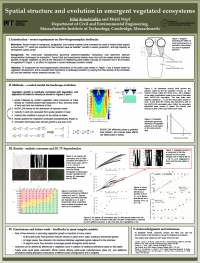CSDMS 2014 annual meeting poster John Kondziolka
Spatial structure and evolution in emergent vegetated ecosystems
Heidi Nepf, MIT Cambridge Massachusetts, United States. hmnepf@mit.edu
Abstract:
Predicting how plant-water landscapes evolve through time is essential for development and restoration work involving natural ecosystems and built environments near waterways. Recent experimental studies show that the interaction and merger of vegetation patch wakes can produce zones of diminished velocity and enhanced deposition that persist downstream and are offset from the patch centerline, which may encourage lateral patterns of growth. These effects are not incorporated into current models of landscape evolution.
In this study, these flow-biogeomorphic interactions at the patch scale are incorporated into a simple model for vegetation development. The model is constructed in Matlab, utilizing MODFLOW, based on a porous media formulation for hydraulic resistance. Landscape evolution over 5 to 300 cycles of vegetation growth produces several categories of realistic landforms. The effect of wakes is shown to consistently alter the steady-state landscape reached by an environment, implying that current models underestimate the effects of vegetation on development.
* Please acknowledge the original contributors when you are using this material. If there are any copyright issues, please let us know and we will respond as soon as possible.

